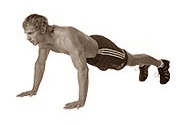How you can reduce push-up hand pain
Push-ups are the most common muscle strengthening exercise, done all over the world. Although safe to do, push-ups can cause injuries and the most vulnerable part of the body is the hands. Orthopaedic surgeons at the Mahidol University in Thailand discovered that athletes can do something about this.Study
The researchers got 10 young men to do push-ups and measured the pressure exerted in different parts of the hand. The figure below shows the different areas of the hand that the researchers distinguished.[FONT="]
[/FONT]

[FONT="]
[/FONT]
P1 = thenar area; P2 = lunate area; P3 = hypothenar area; P4 = metacarpal area; P5 = finger area.
The researchers got their subjects to vary the position of their hands. In position -10 the men placed their hands on the floor shoulder-width apart minus 10 cm. Position +10 was shoulder-width apart plus 10 cm, and 30+ shoulder-width apart plus 30 cm.
Results
The table below shows that the pressure in the lunate area - the area of your palm near the thumb - is less by a statistically significant amount if the hands are placed close together. The pressure in the hypothenar part - the outer side of the palm of your hand - is less when the hands are spread far apart on the floor.
[FONT="]
[/FONT]

[FONT="]
[/FONT]
If you have pain in the outside part of your hand when doing push-ups, it's worth trying the exercise out with your hands further apart. Pain near the thumb would suggest you should place your hands closer together.
The researchers think their findings will be of particular interest to athletes recovering from injury.
Source:
Singapore Med J. 2009 Jul;50(7):702-4.

|
[/FONT]

[FONT="]
[/FONT]
P1 = thenar area; P2 = lunate area; P3 = hypothenar area; P4 = metacarpal area; P5 = finger area.
The researchers got their subjects to vary the position of their hands. In position -10 the men placed their hands on the floor shoulder-width apart minus 10 cm. Position +10 was shoulder-width apart plus 10 cm, and 30+ shoulder-width apart plus 30 cm.
Results
The table below shows that the pressure in the lunate area - the area of your palm near the thumb - is less by a statistically significant amount if the hands are placed close together. The pressure in the hypothenar part - the outer side of the palm of your hand - is less when the hands are spread far apart on the floor.
[FONT="]
[/FONT]

[FONT="]
[/FONT]
If you have pain in the outside part of your hand when doing push-ups, it's worth trying the exercise out with your hands further apart. Pain near the thumb would suggest you should place your hands closer together.
The researchers think their findings will be of particular interest to athletes recovering from injury.
Source:
Singapore Med J. 2009 Jul;50(7):702-4.
